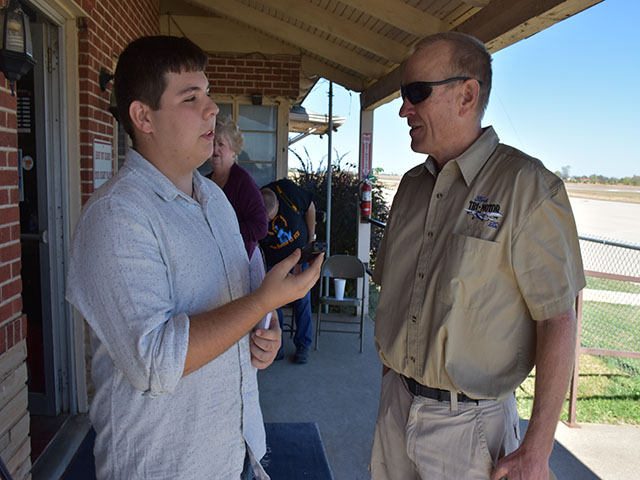A pilot’s perspective
December 14, 2017
Photo: Emily Rhyne
Stopping for a quick interview before the flight, Eric Crowell discusses the Ford Tri:Motor with pilot, John Hartke. The two chat about the Fly the Ford event and why aviation is important to education.
The Ford Tri-motor would be nothing without the man inside the cockpit, John Hartke, an experienced pilot who volunteered to participate in the Fly the Ford program.
With over forty years of experience, Hartke says he was “fairly fortunate as a youngster” as he had the opportunity to learn to fly as a teenager.
“At 14 I began working for the local airport cutting grass and doing the garbage and eventually fueling and washing the planes in exchange for flight lessons,” said Hartke who now flies 737s for a living and has his own small plane. “I began solo flights at 16 and got my pilot’s license at 17.”
Familiar with the plane’s history, Hartke notes how the brief time span between the fathers of flight and the development of the Tri-Motor.
Hartke said, “The Wright Brothers were developing the Wright Glider and successfully attempting flight 25 years earlier before the plane was created. The Tri-motor tripled the Wright brother’s speed.”
Hartke considers the Tri-Motor the “grandfather of all the modern airliners.” Original airliners were innovative, made of metal, and carried 11 passengers while older planes were wooden and carried less.
Hartke notes the next step to modern aviation with the change of times and the end of the Tri-motor era.
“Technological ramping of aviation from the Ford motors soon became obsolete as newer planes carried the same amount of passengers put required 1 less engine,” said Hartke.
As a long time pilot, Hartke has a deep appreciation for the Tri-motor. If it wasn’t for the small Ford plane, aviation as we know it today wouldn’t exist.
